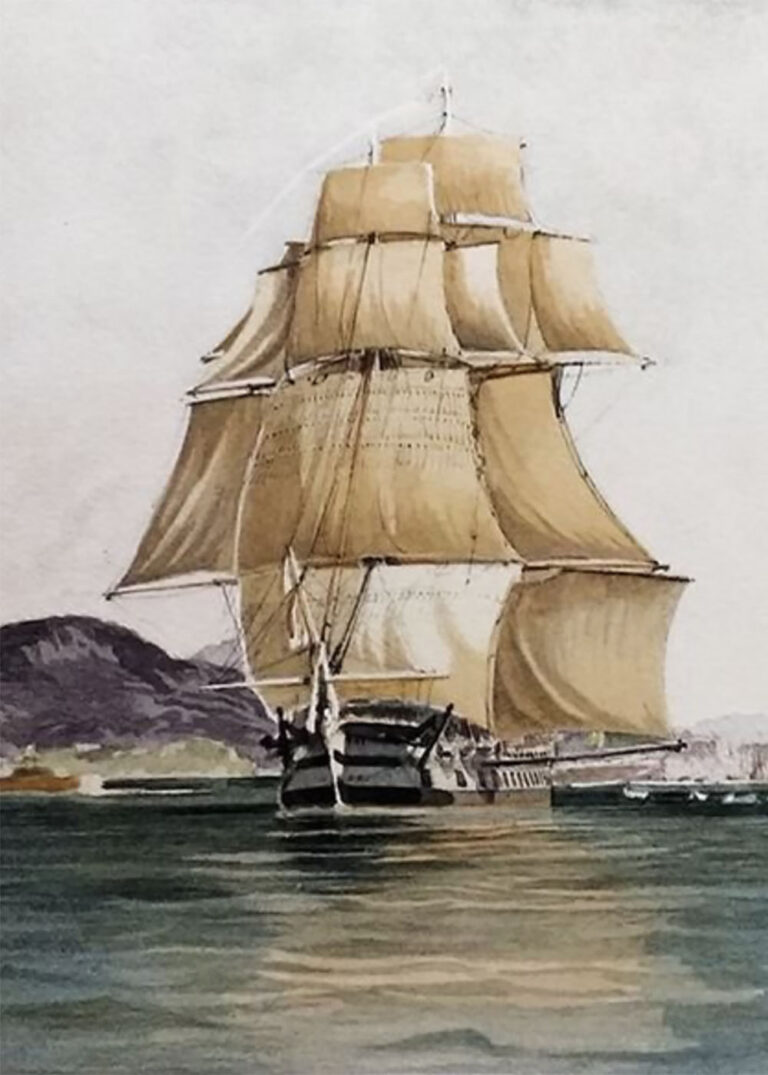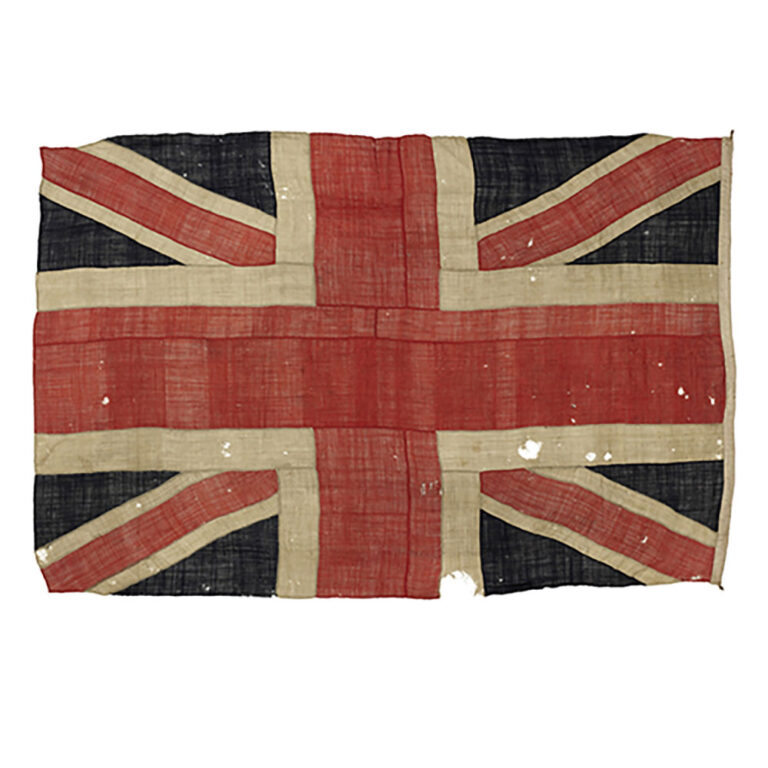This Union Flag would have been flown prominently by HMS Spartiate, most likely from the foretopgallant stay, as she sailed slowly towards the waiting line of the Franco-Spanish fleet off Cape Trafalgar. Under ordinary circumstances Union Jacks were flown only when in port, from a jack staff on the ship’s bowsprit, and their use in battle at Trafalgar was in accordance with a specific order issued by Nelson only 11 days beforehand, on 10 October 1805: ‘When in presence of the Enemy, all the ships under my command are to bear White Colours [i.e. the White Ensign] and a Union Jack is to be suspended from the foretopgallant stay’. This was to enable the British ships to recognise each other in the confusion of battle: Nelson insisted on a yellow and black paint scheme for his ships, the ‘Nelson Chequer’, for the same reason. The Spartiate may possibly have flown more than one Union Jack: a midshipman on the British HMS Neptune, ahead of Spartiate in the windward column, remembered looking back and seeing ‘union-jacks and ensigns … made fast to the fore and fore-topmast-stays, as well as to the mizzen-rigging, besides one at the peak, in order that we might not mistake each other in the smoke’ (Roy Adkins. Trafalgar: The Biography of a Battle, 2004, 97).
The Spartiate sustained three killed and 20 wounded: according to The Trafalgar Roll she ‘had her foretopsail yard shot away, and her masts, yards, and rigging in general were a good deal damaged’. After Trafalgar Spartiate served at Rochefort in 1807-08, and in June 1809 took part in the capture of the islands of Ischia and Procida off Naples: she continued in active service until 1835, before being made a sheer hulk at Plymouth in 1842, where she was broken up in 1857.
It was common practice for warrant officers or junior officers to take ensigns as rewards after a battle: the Spartiate’s second lieutenant, James Clephan (1768-1851) preserved the present flag. Clephan became first lieutenant of Spartiate immediately after Trafalgar, at the special request of Captain Laforey. He was made Commander in 1811, and in the War of 1812 against the United States whilst commanding the sloop Charybdis captured the American privateer Blockade near the Isle of Saba in the Caribbean; he also served in the unsuccessful assault on New Orleans in 1814-15. He went on half-pay on 23 August 1815 and retired with the rank of Captain in 1840, one of only a handful of men to have reached that rank from the lower decks during the Napoleonic period.
Only two other complete British flags are known to survive from Trafalgar, both Union Jacks: the first, from HMS Minotaur (which sailed alongside Spartiate into action) was preserved by Stephen Hilton, Master’s Mate, and subsequently presented by his descendants to the church of St Mary’s, Selling, Kent, from whom it was purchased privately by the National Maritime Museum in 2012, together with an Austrian Ensign thought to have been retrieved by Hilton from the Spanish Neptuno. The second, from HMS Royal Sovereign, was kept by Charles Antram, also Master’s Mate, and remained in private hands until publicly identified in May 2025. Minotaur’s flag is of comparable size to Spartiate’s at 226.5 x 311cm, having suffered a loss to its right-hand edge, and with an oblong section cut away from the lower edge, perhaps as a souvenir; the Union Jack from Royal Sovereign is smaller, at 152.5 x 274.5cm. Fragments of various sizes survive from one of the Union Jacks of HMS Victory, which was cut up for souvenirs by the honour guard of sailors after Nelson’s funeral: a substantial fragment measuring 88 x 94 cm sold at Sotheby’s, 17 January 2018, lot 94 ($617,000).
The Union Flags flown at Trafalgar are the second (and still current) form of the flag, introduced on 1 January 1801 after the 1800 Act of Union with Ireland: the earlier design lacked the cross of St Patrick (the red saltire. As a relatively recent innovation, the red saltire is often incorrectly executed in examples from the early 19th century, reflecting the handmade nature of flags at this period: here the white and red saltires are not counterchanged as they should be. The flag shows signs of battle damage: analysis by the Zaricor Flag Collection revealed shards of metal embedded in the fabric in several places, notably in the half-moon shaped loss to one edge, suggesting that this is the ‘footprint’ of a cannon ball. Fragments of wood splinters were also found throughout.
Information from Christie’s catalogue, The Exceptional Sale, Property from the Zaricor Flag Collection – www.christies.com/en/lot/lot-6542525


